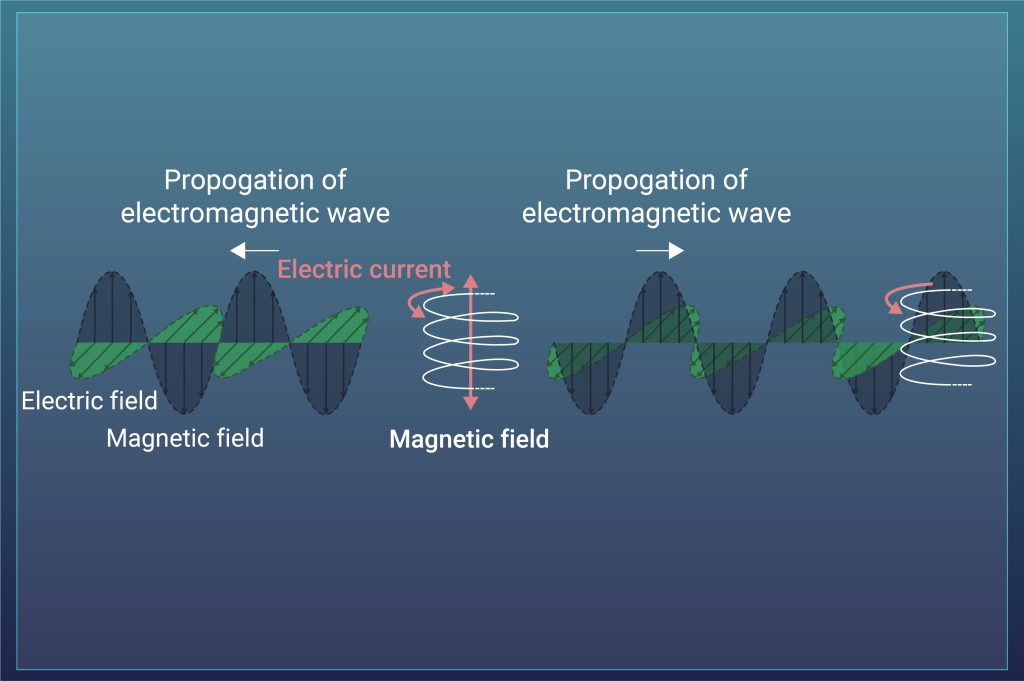While electromagnetic waves such as radio wave, light, X-ray, etc. may be called differently depending on their wavelengths, they all obey the same laws of physics. For example, their speed is 299,792,458 m/s in vacuum, independent of the wavelength.

Whereas the SRPT occurs in thermal equilibrium, it originates from the interaction between the electromagnetic fields and matter (Figure 1), which has long been the target in the research field of light. In other words, the SRPT is a phenomenon that bridges the research fields of light and of thermodynamics (or statistical physics), which have been studied mostly in non-equilibrium and in thermal equilibrium, respectively. This is why we focus on SRPT and why we feel that SRPT has the potential to advance both technology as well as our understanding of the world.
For example, we have revealed that a quantum fluctuation of photons and matter can be highly suppressed (called quantum squeezing) at the critical point of SRPT even in thermal equilibrium (Hayashida et al.), in contrast to the fact that such an effect has been discussed mostly in the non-equilibrium situations. The quantum squeezing in thermal equilibrium is robust against any noise in contrast to the non-equilibrium one, thus we are now trying to construct noise-robust quantum technologies, such as quantum sensing and quantum computing by taking advantage of the quantum squeezing in thermal equilibrium.

The interaction between matter and electromagnetic field forms the basis for a variety of optical technologies such as optical fibers and lenses. Typical phenomena obtained by such interactions (typically called light-matter coupling) are refraction and reflection of electromagnetic waves (Figure 2). When an electromagnetic wave propagates through a medium, they are absorbed and re-emitted by atoms within the medium.
But, how frequently does this happen? In most materials, the rate of the absorption and reemission is lower than the frequency of the electromagnetic wave (for example, 4 × 1014 Hz for red-colored light). However, starting 2009, a variety of artificial materials have been reported to show comparable to or even higher rates of absorption and re-emission of the electromagnetic wave than its frequency. This is called ultra-strong light-matter coupling, where the typical frequency to couple ultra-strongly with matters ranges from radio waves (~ 109 Hz) to ultraviolet light (~ 1015 Hz) depending on the materials. For example, electrons in semiconductor quantum wells, electrons’ cyclotron motion, dye molecules, spin-waves in magnetic materials, optical phonons, plasmons, carbon nanotubes, superconducting circuits, etc. can show ultra-strong coupling (see a review, for example, Forn-Díaz et al.).
One of the most interesting properties caused by the ultra-strong light-matter coupling is the occurrence of the superradiant phase transition (SRPT) (see Theme 1). Another property is an emergence of quantum states of light and matters in the ground state of the coupled system or in thermal equilibrium at finite temperatures. In the absence of the light-matter coupling, the ground state is simply expressed as the vacuum of electromagnetic fields (no photons exist). In the presence of the light-matter interaction, the ground state of the coupled system is generally expressed as a quantum state (in the original basis of light and matters), such as a quantum squeezed state (showing suppressed quantum fluctuation of electromagnetic fields) (Read more here). The “quantumness” becomes considerable in the ultra-strong coupling regime, whereas it is negligible if the coupling is not so strong. While such “quantumness” has been neglected mostly in the studies of light, its observation and functionalities are now going to be realistic thanks to the recent findings of the ultra-strongly coupled systems.
We have theoretically elucidated that perfect squeezing can be obtained at the critical point of the SRPT (read more here). Further, we have demonstrated experimentally a signature of such squeezing by observing the so-called vacuum Bloch-Siegert shift (read more here). We have also demonstrated control of the light-matter coupling strength from weak to ultra-strong regimes by fabricating samples consisting of carbon nanotubes (Gao et al.) and by applying a magnetic field to magnetic materials (Makihara et al.). A variety of theoretical investigations on the laser, coupling with environments, etc. in the ultra-strong coupling regime have also be investigated theoretically.
We are now studying the functionalities, such as quantum sensing and quantum computing, of the quantum states obtained in the ultra-strongly coupled light-matter systems in thermal equilibrium. We believe that the quantum states in thermal equilibrium may revolutionize these technologies in the sense that they become robust against noise (decoherence). We are also trying to demonstrate that our idea is realistic. We believe that such challenging and creative studies are necessary in the world and such studies will lead to the welfare and sustainability of humans.